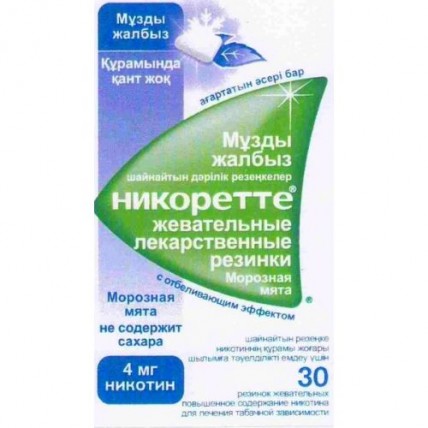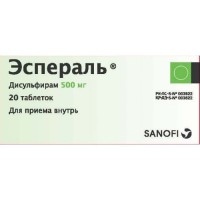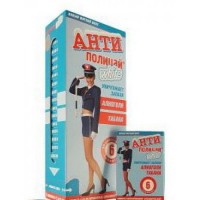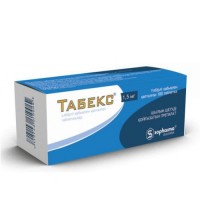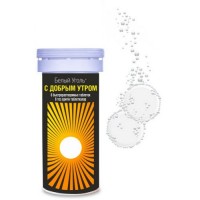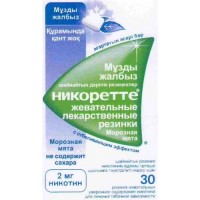Nicorette 4 mg gum 30s Gesves. drugs. frosty mint
- $26.60
Sku:
063888bbad5d
Ingredient:
Nicotine
The instruction for medical use of Nikorette medicine ® the Trade name of Nikorette ® the International unlicensed name Is not present the Dosage form Chewing medicinal gums Frosty mint 2 mg, 4 mg Structure One chewing gum contains active agent – nicotine resinate of 10.00 mg or 20.00 mg, is equivalent to nicotine of 2.00 mg or 4.00 mg, excipients: kernel of chewing gum: chewing gum (basis) *, ksilitol (E967), oil of a peppermint, sodium a carbonate anhydrous, Natrii hydrocarbonas (for a dosage of 2 mg), potassium to atsesulfa, left menthol, magnesium oxide, yellow quinolinic (E104) (for a dosage of 4 mg), an internal cover: Winterfresh fragrance, gipromelloza, sucralose, polysorbate 80, external cover: ksilitol (E967), starch corn prezhelatinizirovanny, the titan dioxide (E171), Winterfresh fragrance, wax karnaubsky, yellow quinolinic (E104) (for a dosage of 4 mg). * A basis of chewing gum – mix of various types of wax, pitch and other hydrocarbons (about 60%) and carbonate calcium (up to 40%). The description Square, coated white or almost white color (for a dosage of 2 mg) or color, light yellow with a brownish or greenish shade (for a dosage of 4 mg) small pillows, with a characteristic smell, about 15×15×6 mm in size. For both dosages the presence of small roughnesses is allowed on each side. The pharmacotherapeutic group of Means for treatment of nicotine addiction the ATX N07BA01 Code the Pharmacological Pharmacokinetics Nicotine properties arriving from chewing gum is quickly soaked up through a mucous membrane of an oral cavity and it is found in blood in 5–7 min. The maximum concentration of nicotine is reached in 30 min. after the beginning of chewing. The volume of distribution of nicotine at intravenous administration equals about 2-3 l/kg, and elimination half-life — about 2 h. Nicotine is generally removed by a liver, its average plasma clearance is about 70 l/h. Nicotine is metabolized also in kidneys and lungs. More than 20 metabolites of nicotine which concede to it on activity are identified. Communication of nicotine with proteins of plasma makes less than 5%. In this regard disturbances of binding of nicotine at simultaneous use of other drugs or changes of concentration of proteins of plasma in various diseases should not have significant effect on nicotine kinetics. Primary metabolite of nicotine in plasma — kotinin — possesses elimination half-life of 15-20 h, and its concentration exceeds that of nicotine by 10 times. With urine also trance-3-hydroxy-kotinin (45% of a dose) are removed generally kotinin (15% of a dose). From 10% to 30% of a dose of nicotine it is removed with urine in not changed look. The progressing deterioration in function of kidneys is followed by decrease in the general clearance of nicotine. Its pharmacokinetics does not change at patients with cirrhosis with slightly profound abnormal liver functions (5 points on a scale of Chayld-Pyyu) and decreases at patients with cirrhosis with a moderate abnormal liver function (7 points on a scale of Chayld-Pyyu). At the smokers with the accompanying chronic kidney disease receiving treatment by a hemodialysis noted increase in concentration of nicotine in blood plasma. At elderly patients the small decrease in the general clearance of nicotine is noted that does not demand dose adjustment. A pharmacodynamics After sharp refusal of smoking at the patients who were daily using tabakosoderzhashchy products for a long time the development of a syndrome of cancellation which includes is possible: a dysphoria, insomnia, acrimony, alarm, disturbance of concentration of attention, decrease in heart rate, increase in appetite or an increase in weight. An important symptom of a syndrome of cancellation is also desire to smoke. At treatment of tobacco addiction the replacement therapy by nicotine reduces the need for number of the smoked cigarettes, reduces expressiveness of the symptoms of cancellation arising at total rejection of smoking at those who decided to leave off smoking facilitates temporary abstention from smoking and also promotes reduction of quantity of the smoked cigarettes at those who cannot or do not want to refuse smoking completely. Promotes removal of the pigmented plaque on teeth, has the bleaching effect. Indications Treatment of tobacco addiction by decrease in need for nicotine in the following cases: - reduction of the symptoms of cancellation arising at total rejection of smoking at the patients who decided to leave off smoking - at temporary refusal of smoking - reduction of quantity of the smoked cigarettes at those who cannot or do not want to refuse completely smoking the Route of administration and doses the Dose is selected individually depending on intensity of smoking. Никоретте® chewing gums of 2 mg (moderate content of nicotine) should be applied if the patient smokes less than 20 cigarettes a day or smokes the first cigarette in 30 minutes after awakening. Никоретте® chewing gums of 4 mg (the increased nicotine content) should be applied if the patient smokes more than 20 cigarettes a day or he did not manage to leave off smoking at use of chewing gum in a dose 2 mg. Никоретте® it is necessary to apply in all cases when there is insuperable desire to smoke, according to the following scheme: To slowly chew chewing gum before emergence of sharp taste. To stop chewing and leaving chewing gum between the interior of a cheek and a gum. When the taste disappears, to begin to chew chewing gum again. Total rejection of smoking Adults At a time it is necessary to chew only one small pillow, having stopped smoking. At total rejection of smoking the amount of chewing gums in day is defined by degree of dependence on nicotine, but usually is 8-12 pieces a day and should not exceed 15 pieces a day. It is necessary to apply chewing gum in the specified dose up to 3 months then the daily number of chewing gums should be reduced to full cancellation gradually. Drug stops being used when the daily dose makes 1-2 pieces a day. The adults passing nicotine replacement therapy for more than 9 months are recommended to ask for the additional help and to consult with the expert. Reduction of quantity of the smoked cigarettes Adults Chewing gum should be applied between smoking episodes to lengthening of intervals between smoking of cigarettes as much as possible to reduce consumption of cigarettes. If within 6 weeks it was not succeeded to achieve decrease in daily consumption of cigarettes, it is necessary to ask for the help the expert. The attempt to leave off smoking should be undertaken as soon as the smoker feels that he is ready to it, but no later than in 6 months after the beginning of therapy. If within 9 months after the beginning of therapy it was not succeeded to achieve decrease in daily consumption of cigarettes, it is necessary to address the expert. Simultaneous carrying out medical consultation and ensuring psychological support usually increase efficiency of therapy. The temporary refusal of smoking Chewing gum can be applied during the periods when it is necessary to refrain from smoking, for example, at stay in places where it is forbidden to smoke, or in other situations when it is necessary to refrain from smoking. Use in a combination with a transdermal therapeutic system with nicotine (plaster) Nikorette® the Smokers who did not manage to leave off smoking only at use of chewing gums or which want to reduce daily consumption of chewing gums because of the local undesirable phenomena can apply a plaster of Nikorette® together with chewing gum of 2 mg. Initial therapy: Treatment it is necessary to begin with one plaster 15 mg / 16 hours which is placed every day on the intact site of skin after awakening in the morning and delete before going to bed, in a combination with chewing gum of 2 mg. Apply at least 4 chewing gums on 2 mg a day, usually there are enough 5 – 6 chewing gums. The full dose should be applied within 6 – 12 weeks then it is necessary to wean from drug gradually. Disaccustoming from a combination of drugs: It can be done in two ways. The first way: by means of use of a plaster of a smaller dosage, i.e. use of a plaster of 10 mg / 16 hours within 3 – 6 weeks and the subsequent use within 3 – 6 weeks of a plaster of 5 mg / 16 hours with the same amount of chewing gums on 2 mg as at initial therapy, and then gradually reducing amount of chewing gums on 2 mg within 12 months. Other way consists in phase-out of a plaster and gradual decrease in amount of chewing gums on 2 mg within 12 months. The recommended dosage: Initial therapy the Span the Plaster Chewing gum of 2 mg the First 6 – 12 weeks 1 plaster of 15 mg / 16 hours Is daily recommended 5 – 6 chewing gums a day. Disaccustoming – a way 1 Following of 3 - 6 weeks 1 plaster of 10 mg / 16 hours daily to Continue to apply chewing gums as necessary the Following of 3 - 6 weeks 1 plaster of 5 mg / 16 hours daily to Continue to apply chewing gums as necessary Up to 12 months---------------Gradual disaccustoming from use of the Disaccustoming chewing gum – way 2 Up to 12 months Gradual disaccustoming from use of chewing gum not to exceed the specified doses! It is necessary to carry chewing gum with itself to use it, if desired to light. Side effects In the recommended dose the Nikorette® chewing gum does not cause serious adverse effects. In an initiation of treatment the nicotine which is contained in chewing gum can sometimes cause weak irritation of a throat and the strengthened salivation. At ingestion of excessive amount of the dissolved nicotine in an initiation of treatment the hiccups is possible. Overconsumption of the Nikorette® chewing gum by the persons who are not accustomed to inhalation of tobacco smoke can lead to nausea, weakness or headaches (similar to the symptoms arising at such patients at inhalation of tobacco smoke). Very often - a headache - gastrointestinal discomfort, a hiccups, nausea - a sore throat or in a mouth, masseter pain, stomatitis, pharyngitis Often - dizziness - vomiting Seldom - a cardiopalmus - allergic reactions: the erythema, a small tortoiseshell, a Quincke's disease Very seldom - atrial disturbances of a rhythm Some symptoms, such as dizziness, headache and sleep disorder, can be connected with the symptoms of cancellation arising at abstention from smoking. After refusal of smoking the patients can have with the increased frequency aphthous ulcers. At persons with predisposition to a digestive disturbance in an initiation of treatment Никоретте® 4 chewing gum of mg insignificant digestive disturbances or heartburn are possible, usually this problem is fixed at slower chewing of an elastic band and use of the elastic band containing 2 mg of nicotine (if necessary, with smaller intervals). Contraindications - hypersensitivity - children's and teenage age up to 18 years With care the Nikorette® Chewing gum should be applied to nicotine or other components of chewing gum only after consultation with the doctor to patients with disturbances of a cardiovascular system, in particular had serious cardiovascular diseases within 1 month before use (such as stroke, unstable stenocardia, arrhythmia, myocardial infarction, shunting or angioplasty) or with uncontrollable arterial hypertension. It is necessary to appoint the Nikorette® chewing gum with care the patient with the moderate or profound abnormal liver function, a heavy renal failure, exacerbation of a peptic ulcer of a stomach and duodenum. The nicotine coming to a human body at replacement therapy or smoking causes release of catecholamines from a medulla of adrenal glands. In this regard patients need to apply the Nikorette® chewing gum with care with an uncontrollable hyperthyroidism, a pheochromocytoma and also diabetes. Medicinal interactions Smoking (but not nicotine) causes increase in activity of an isoenzyme of CYP1A2. After smoking cessation the decrease in clearance of substrates of this enzyme can be observed. It can lead to increase in concentration of some medicines in blood plasma that has potential clinical value at use of the drugs which are characterized by the small width of therapeutic action such as theophylline, takrin, clozapine and ropinirol. Limited data demonstrate that smoking can induce metabolism of a flekainid and pentazocine Special instructions At smokers who carry removable dentures, there can be difficulties when chewing Nikorette. Persons with disturbance of chewing function are recommended to apply other dosage forms. Nikorette patients should appoint with care with a serious illness of a cardiovascular system (okklyuziruyushchy diseases of peripheral arteries, diseases of vessels of a brain, stable stenocardia and heart failure in a decompensation stage), at angiospasms, to patients with arterial hypertension resistant to control, crushing/medium-weight damages of a liver, severe damages of kidneys, in a peptic ulcer of a stomach and duodenum in an aggravation stage. Nicotine as the nicotine coming to an organism during replacement therapy - the containing drugs, and coming to smoking time, causes release of catecholamines in marrow of adrenal glands. Therefore Nikorette should appoint also with care to patients with a hyperthyroidism or a pheochromocytoma. Decrease in doses of insulin can be required by patients with diabetes as a result of refusal of smoking. If medicine became useless or the expiration date expired - it is not necessary to throw out it in sewage or on the street! It is necessary to place medicine in a package and to put in a garbage container. These measures will help to protect the environment! Pregnancy and a lactation Nikotin gets through a placenta and is allocated with breast milk and its use can constitute danger to a fruit or the child. Patients should be informed on need to make an attempt of refusal of smoking without nicotine replacement therapy. In case of unsuccessfulness of such attempts the decision on performing therapy is made after comparison of possible positive effect for mother and potential harm for a fruit. Nicotine in insignificant quantity gets to breast milk even at reception in therapeutic doses that can negatively affect health of the child at administration of drug by the nursing mother. For the purpose of reduction of negative influence of nicotine by the child the Nikorette® chewing gum should be applied at once after feeding and not later than 2 hours before the next feeding. Negative impact on ability to driving of the car and work with mechanisms is not established to feature of influence of medicine on ability to run the vehicle and potentially dangerous mechanisms. The overdose Excessive intake of nicotine at replacement therapy and/or smoking can cause emergence of symptoms of overdose. Symptoms: are similar to those in acute poisoning with nicotine and include nausea, salivation, an abdominal pain, diarrhea, perspiration, a headache, dizziness, a hearing disorder and the significant weakness. At use of high doses of nicotine the lowering of arterial pressure, low and irregular pulse, the complicated breath, circulator collapse and generalized spasms can be noted. Nicotine in the doses transferred by adult smokers can cause in small children the expressed symptoms of intoxication, including from the death. Treatment: it is necessary to stop immediately Nikorette's use and to appoint symptomatic treatment. Activated carbon reduces absorption of nicotine in digestive tract. If necessary carry out artificial ventilation of the lungs and appoint oxygen. Form of release and packing Chewing medicinal gums Frosty mint of 2 mg, 4 mg. On 15 elastic bands place in blister strip packaging from a film of polyvinylchloride and aluminum foil. On 1, 2 or 7 planimetric packs together with the instruction for medical use in the state and Russian languages put in a cardboard pack. To Store storage conditions at
a temperature not above 25 °C. To store out of children's reach. A period of storage 3 years Prescription status Without prescription the Producer McNeal of AB, Helsingborgs IF, SE-251 09, Norbroplattsen 2, Sweden the Name and the country of the owner of the registration certificate of LLC Johnson & Johnson, Russian Federation, 121614, Moscow, Krylatskaya St., 17, building 2, ph. (495) 726-55-55 The name and the country of the organization packer McNeal of AB, Helsingborgs IF, SE-251 09, Norbroplattsen 2, Sweden the Address of the organization accepting in the territory of the Republic of Kazakhstan claims from consumers on quality of products (goods) of TV-Pharma LLP, Almaty, mdt. Zhetysu 3, 1, quarter 7
to Develop
a temperature not above 25 °C. To store out of children's reach. A period of storage 3 years Prescription status Without prescription the Producer McNeal of AB, Helsingborgs IF, SE-251 09, Norbroplattsen 2, Sweden the Name and the country of the owner of the registration certificate of LLC Johnson & Johnson, Russian Federation, 121614, Moscow, Krylatskaya St., 17, building 2, ph. (495) 726-55-55 The name and the country of the organization packer McNeal of AB, Helsingborgs IF, SE-251 09, Norbroplattsen 2, Sweden the Address of the organization accepting in the territory of the Republic of Kazakhstan claims from consumers on quality of products (goods) of TV-Pharma LLP, Almaty, mdt. Zhetysu 3, 1, quarter 7
to Develop
